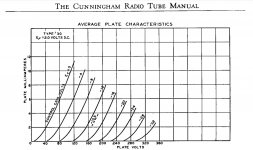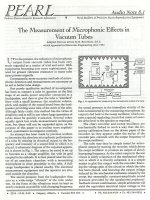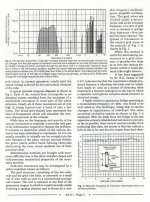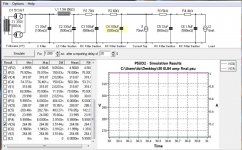I'm currently using the 0B2 setup. With the 30s installed I'm getting ~99v plate to ground. The DCR of the 156C is listed as 3.7k but they measure ~3.45k. The filament is at 1.8v.
I just tried the 0A2 setup with them, which resulted in a plate to ground voltage of ~140.5v. They were considerably more microphonic at that operating point. The 26s are quieter with the 0B2 setup too, so that's what I'll be using.
If microphonics continue to cause you problems, maybe consider using the 864 / VT-24. But, as I said, I don't consider it a problem if it's not audible under normal listening conditions. Lots of tubes will ping if you tap them, even many indirectly heated ones. So, I just don't tap them.
It's interesting that you experienced more microphonics at the higher voltage. There isn't really any need to run at my proposed 135 Volts with the power tubes I'm using if I can get away with a lower voltage and also get less microphonics.
Quick question. I’m looking at lower voltage operating points for the 30. 100-115 volts. What should I consider as being the upper limit for current draw for a 30? In the class A1 amplifier portion of the data sheet it shows 3.1 mA, but it doesn’t say it’s a maximum. Would 4 mA be okay? 3.5 mA?
euro21: No dissipation limit on the data sheet makes me nervous. They seem like a fairly sturdy tube with a biggish plate. 3 mA will be fine though. Thanks!
If you see the whole datasheet, the mu, rp, gm curves shows data at even 8mA anode current.
The accepted opinion -in the case of ancient datasheets- that curves "end point" represents the suggested maximum dissipation curve.
The 4-5mA region (at 100-120V) is within the safe range.
The accepted opinion -in the case of ancient datasheets- that curves "end point" represents the suggested maximum dissipation curve.
The 4-5mA region (at 100-120V) is within the safe range.
Attachments
euro21: Thanks for the info. I may try running it at higher current later. My priority is minimizing microphonics at this point. FlaCharlie noticed reduced microphonics at lower voltages, but I'm not sure what current contributes. I'll try it and find out if it makes a difference.
Lower voltage/current for filament supply for DHT plays significant role in reducing micro-phonics. This is from my own experience. It should be within 5% of datasheet quoted value I think.
Regards
Regards
euro21: No dissipation limit on the data sheet makes me nervous. They seem like a fairly sturdy tube with a biggish plate. 3 mA will be fine though. Thanks!
If you see the whole datasheet, the mu, rp, gm curves shows data at even 8mA anode current.
The accepted opinion -in the case of ancient datasheets- that curves "end point" represents the suggested maximum dissipation curve.
The 4-5mA region (at 100-120V) is within the safe range.
The data sheet says "Plate voltages and the corresponding grid voltages should be determined from the CHARACTERISTICS and the curves in order to maintain optimum performance and freedom from distortion."Lower voltage/current for filament supply for DHT plays significant role in reducing micro-phonics. This is from my own experience. It should be within 5% of datasheet quoted value I think.
The plate current range is from 2.5 to 3.1 mA in the table. Plate voltages shown range from 90v to 180v, which is listed as the maximum.
I'm generally of the opinion that voltage and current can be fudged a little (within reason) and that dissipation is more important. I'm definitely not the smartest guy in the room, though.
Of course individual tubes will vary and the two I was using measured 3.15 mA and 2.93 mA in my setup.
I've also read that reduced filament voltage can result in less microphonics.
Since my SMPS is adjustable I tried lowering the voltage. With it adjusted to max I was running at 1.8v, which is about 10% under the 2v spec. That was as close as I could get to 2v with resistors I had on hand.
Adjusting it down to the minimum put 1.09v on the filament. At that point, one tube exhibited lower microphonics and the other was essentially not microphonic at all.
Obviously, there will be a lot of variation between tubes. I have several 30s - all are NOS JAN - but I only used two of them in the test. They were initially selected because they seemed to match well in terms of transconductance and current. Both tested at 950 with 900 being average new value. Current was measured in circuit.
So, since you have quite a few 30s you might find that some are quieter than others.
In addition to lowering microphonics, starving the filaments also seems to lower distortion. I plan to try this with the 26s but all I have is my ears. Not sure if it will be audible or what other effects it might have.
DHT with starved filaments.
Last edited:
Mullard Technical Commuications #61 November 1962
Link to several of the best, one on Microphonics-
The Valve Techie Page
🙂
Link to several of the best, one on Microphonics-
The Valve Techie Page
🙂
The amp is completed, but not yet put into its wooden case. I have had a chance to do some listening and comparisons.
I ended up using the cheap AliExpress sourced black OPTs I posted a link for a while back for the first round of listening, and I will try a couple of other pairs of OPTs after that.
The amp has a bit of hum through the La Scalas that I have been using with it. The hum is more audible than with any of the other IDHT amps in rotation. I plan on doing a couple of things that should improve the hum. It's not really offensive at the listening position, and manifests itself as an increase in the noise floor and the room not being completely silent. Not a deal breaker, but not ideal either. The amp hums more when using EL84 than it does when using 6V6. I suspect that has to do with the way I wired the power tubes together in parallel so that I could use one or the other. I tried around 8 pairs of 30 tubes in the amp. Some tubes hum a bit more than others, but hum is audible with all 30s.
With respect to microphonics, some 30s are better than others. The globes are the worst, but the 30 globes I have are all a little better than any of the 01A that I tried. In my my albeit limited experience, the 30 is not particularly microphonic as compared to the other DHTs I have tried. Some 30 tubes, around 1 in 8. are not microphonic at all. As was the case with the 01A tubes, the microphonics are not an issue in practice. At high volume in my listening room, using a 30 globe, if I pause the music while next to the speakers, there is no overhang or continued ringing audible. Ringing only happens when I tap the tubes directly. My experimental tube socket isolation setup works well enough that tapping on the top plate doesn't get the 30s ringing, so I am going to call that a win.
Now for the sound. The frequency spectrum sounds somewhat skewed toward the mids and highs. The amp sounds crisp and clean, as though it has sharper mid and high frequency transients than my other amps. Venue ambience is better than the IDHT amps in rotation. There is more sense of the room that the music is being played in when the recording allows. Well recorded voices sound very real and present. What folks call PRAT is somewhat lacking with this amp while using its current OPTs. I suspect that the skewing is likely partially due to the OPT used for the initial listening, and I will try other OPTs to hear what it sounds like. Combined with a beefier amp doing frequencies below 630 HZ these qualities may serve its intended purpose as a treble amp well.
I ended up using the cheap AliExpress sourced black OPTs I posted a link for a while back for the first round of listening, and I will try a couple of other pairs of OPTs after that.
The amp has a bit of hum through the La Scalas that I have been using with it. The hum is more audible than with any of the other IDHT amps in rotation. I plan on doing a couple of things that should improve the hum. It's not really offensive at the listening position, and manifests itself as an increase in the noise floor and the room not being completely silent. Not a deal breaker, but not ideal either. The amp hums more when using EL84 than it does when using 6V6. I suspect that has to do with the way I wired the power tubes together in parallel so that I could use one or the other. I tried around 8 pairs of 30 tubes in the amp. Some tubes hum a bit more than others, but hum is audible with all 30s.
With respect to microphonics, some 30s are better than others. The globes are the worst, but the 30 globes I have are all a little better than any of the 01A that I tried. In my my albeit limited experience, the 30 is not particularly microphonic as compared to the other DHTs I have tried. Some 30 tubes, around 1 in 8. are not microphonic at all. As was the case with the 01A tubes, the microphonics are not an issue in practice. At high volume in my listening room, using a 30 globe, if I pause the music while next to the speakers, there is no overhang or continued ringing audible. Ringing only happens when I tap the tubes directly. My experimental tube socket isolation setup works well enough that tapping on the top plate doesn't get the 30s ringing, so I am going to call that a win.
Now for the sound. The frequency spectrum sounds somewhat skewed toward the mids and highs. The amp sounds crisp and clean, as though it has sharper mid and high frequency transients than my other amps. Venue ambience is better than the IDHT amps in rotation. There is more sense of the room that the music is being played in when the recording allows. Well recorded voices sound very real and present. What folks call PRAT is somewhat lacking with this amp while using its current OPTs. I suspect that the skewing is likely partially due to the OPT used for the initial listening, and I will try other OPTs to hear what it sounds like. Combined with a beefier amp doing frequencies below 630 HZ these qualities may serve its intended purpose as a treble amp well.
Last edited:
Tizman......you said it hums more with El84. I think its because El84 mu in triode is about 20 vs 6v6 mu 8 or 9. I also think your PS should be improved to tackle the remaining hum. CONGRATULATIONS! I am very happy that you have taken the project this far!!
Your situation proves again that one particular DHT/solution doesn't fit everybody's listening/listening environment. Will you please show us the present PS, so that we understand better?
Untill a proven and good OPT is used SQ should not be assessed. In my experience building a DHT amp, be it all DHT, DHT in the input or output is very different than building an IDHT amp.
Regards
Your situation proves again that one particular DHT/solution doesn't fit everybody's listening/listening environment. Will you please show us the present PS, so that we understand better?
Untill a proven and good OPT is used SQ should not be assessed. In my experience building a DHT amp, be it all DHT, DHT in the input or output is very different than building an IDHT amp.
Regards
Power supply for 30 tube and EL84/6V6 amp
This is the power supply as it is in the amp. The PSUD2 simulation shows 2 millivolts of ripple on the power tube B+, and 3.5 microvolts of ripple on the 30 B+. This seems low enough that it shouldn't be audible through the La Scalas. There is no volume pot on the amp at the moment, and the amp has barely enough gain for the regular 2 volt source I am using for testing. A bit more gain would be better, and I may put together either a C4S CCS or the Bartola Gyrator for that purpose. Before that, I need to sort out the hum.
This is the power supply as it is in the amp. The PSUD2 simulation shows 2 millivolts of ripple on the power tube B+, and 3.5 microvolts of ripple on the 30 B+. This seems low enough that it shouldn't be audible through the La Scalas. There is no volume pot on the amp at the moment, and the amp has barely enough gain for the regular 2 volt source I am using for testing. A bit more gain would be better, and I may put together either a C4S CCS or the Bartola Gyrator for that purpose. Before that, I need to sort out the hum.
Attachments
Untill a proven and good OPT is used SQ should not be assessed. In my experience building a DHT amp, be it all DHT, DHT in the input or output is very different than building an IDHT amp.
I will swap out the OPTs with a pair from a Decware SE84CS that I have at hand.
Any such active load has at least 40-60dB PSRR, so PSU filtration of this magnitude is unnecessary... I may put together either a C4S CCS or the Bartola Gyrator for that purpose. Before that, I need to sort out the hum.
euro21: Good to know. It’s already there, so it’s easier to leave it in that remove it. It seems odd that I am still getting some hum with the Coleman regulator on the filaments, and the low ripple that I have from the power supply. Is it that DHTs are more prone to hum? I am using very sensitive speakers, but it’s been easy to keep IDHT amps quiet with these same speakers.
1. I always consider RMS reading
2. I didn't need this much capacitance in my dht amp
3. Of-course dhts are more prone to hum
4. Fore more gain you may like to use 841 (mu 30), 3b7 (mu 15), 3a5 (mu 15)
If you feel you need to improve you PS please tell us! You don't need more than 2pi for B+ and 1pi for B++.
2. I didn't need this much capacitance in my dht amp
3. Of-course dhts are more prone to hum
4. Fore more gain you may like to use 841 (mu 30), 3b7 (mu 15), 3a5 (mu 15)
If you feel you need to improve you PS please tell us! You don't need more than 2pi for B+ and 1pi for B++.
tizman.....you have the patience to deal with the issues. It will take some time. That's why I always advise people to start building immediately (in its simplest form). Because you don't know in advance what kind of circuit / component / config will give you satisfaction viz auto-bias or fixed bias, CCS/choke/resistor as plate load, filament bias or?
To me and many of us filament bias is best.
Regards
To me and many of us filament bias is best.
Regards
What would a filament bias setup for a 30 tube look like? There are plenty of examples for 01A and 26, but I haven't seen one for the 30 tube. What would my transformer secondary and raw DC voltage need to be?
For filament bias calculation:
Filament Bias: a practical example with 3A5 DHT – Bartola(R) Valves
Before going for filament bias or ccs/gyrator/choke etc. you should fix hum and gain issues.
Regards
Filament Bias: a practical example with 3A5 DHT – Bartola(R) Valves
Before going for filament bias or ccs/gyrator/choke etc. you should fix hum and gain issues.
Regards
- Home
- Amplifiers
- Tubes / Valves
- DHT driver for triode wired SE EL84, 6V6 or EL34




